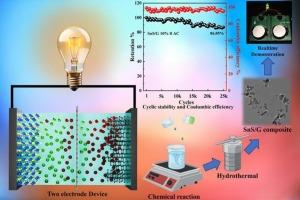Unlocking the potential of highly stable pseudocapacitive performance in asymmetric SnS/Graphite||AC hybrid supercapacitors via hydrothermal method
IF 8.9
2区 工程技术
Q1 ENERGY & FUELS
引用次数: 0
Abstract
Tin-based chalcogenides are promising materials for energy storage but are hindered by intrinsic low conductivity and structural instability. Here, we report a high-performance tin sulfide/graphite (SnS/G) composite that addresses these challenges by strategically incorporating graphite into the SnS matrix. Graphite enhances electrical conductivity, alters the interlayer spacings and provides a stress-buffering network, significantly improving the composite's electrochemical stability. The SnS/G composite, fabricated via a cost-effective hydrothermal method, exhibits a micro-rod morphology with high surface area and excellent ionic transport properties. Electrochemical characterisation of the SnS/G electrode in half-cell configuration reveals a remarkable specific capacitance of 411.6 F/g at 1 A/g and exceptional cycling stability, retaining 96 % of its initial capacitance after 1200 cycles. When assembled into an asymmetric supercapacitor (ASC) with activated carbon (AC) (SnS/G||AC (1.0 V)), the device achieves a specific capacitance of 187 F/g. Along with an energy density of 26.03 Wh/kg, a power density of 5000 W/kg and outstanding long-term stability with 86 % retention after 25,000 cycles for the full cell is achieved. For SnS/G 10 %|| AC (1.5 V) device delivers an energy density of 39.50 Wh/kg and a power density of 7500 W/kg, with 92 % retention after 6000 cycles. These findings underscore the promise of SnS/G composites as scalable, low-cost, high-performance electrodes for next-generation energy storage systems.

通过水热法解锁非对称SnS/石墨||交流混合超级电容器高稳定赝电容性能的潜力
锡基硫族化合物是一种很有前途的储能材料,但其固有的低电导率和结构不稳定性阻碍了它的发展。在这里,我们报道了一种高性能硫化锡/石墨(SnS/G)复合材料,通过将石墨战略性地结合到SnS基体中来解决这些挑战。石墨提高了导电性能,改变了层间的间距,并提供了一个应力缓冲网络,显著提高了复合材料的电化学稳定性。通过经济高效的水热方法制备的SnS/G复合材料具有高表面积和优异的离子传输性能的微棒形态。在半电池结构下,SnS/G电极的电化学特性表明,在1 a /G下,其比电容达到411.6 F/ G,并且具有优异的循环稳定性,在1200次循环后仍保持96%的初始电容。当与活性炭(AC) (SnS/G||AC (1.0 V))组装成非对称超级电容器(ASC)时,该器件可实现187 F/ G的比电容。除了26.03 Wh/kg的能量密度外,还实现了5000 W/kg的功率密度和出色的长期稳定性,在充满电池的25,000次循环后保持86%的保留率。对于SnS/G, 10% || AC (1.5 V)器件的能量密度为39.50 Wh/kg,功率密度为7500 W/kg,在6000次循环后保持92%。这些发现强调了SnS/G复合材料作为下一代储能系统的可扩展、低成本、高性能电极的前景。
本文章由计算机程序翻译,如有差异,请以英文原文为准。
求助全文
约1分钟内获得全文
求助全文
来源期刊

Journal of energy storage
Energy-Renewable Energy, Sustainability and the Environment
CiteScore
11.80
自引率
24.50%
发文量
2262
审稿时长
69 days
期刊介绍:
Journal of energy storage focusses on all aspects of energy storage, in particular systems integration, electric grid integration, modelling and analysis, novel energy storage technologies, sizing and management strategies, business models for operation of storage systems and energy storage developments worldwide.
 求助内容:
求助内容: 应助结果提醒方式:
应助结果提醒方式:


